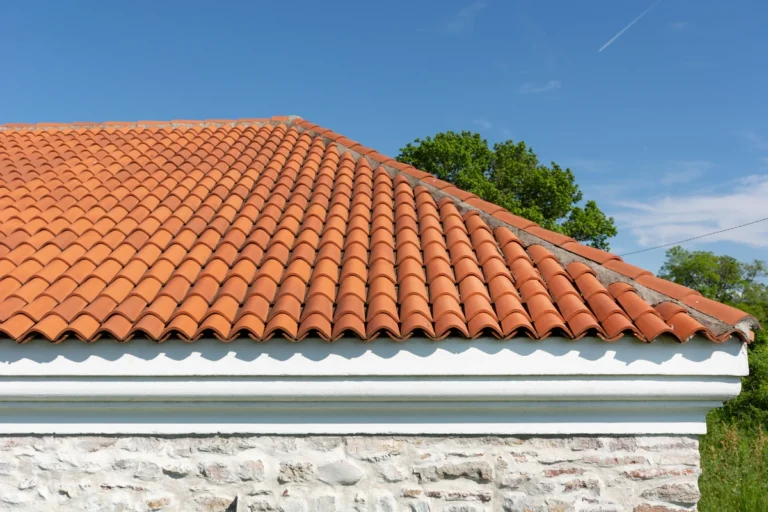Your roof is one of the most critical components of your home, protecting you and your belongings from the elements. Among its various parts, roof tiles play a significant role in safeguarding your house against rain, snow, wind, and other weather conditions. However, over time, roof tiles can become damaged or worn out, compromising their effectiveness and potentially leading to leaks and other issues.
In this blog, we’ll explore:
- The signs of damaged roof tiles
- The options of DIY replacement versus hiring a professional
- Step-by-step instructions on how to replace roof tiles
- The costs involved
- Tips for caring for your tile roof
- When it’s time to consider a full roof replacement
Signs of Damaged Roof Tiles
Before diving into the replacement process, it’s essential to identify whether your roof tiles are damaged and in need of replacement. Here are some common signs to watch out for:
- Missing Tiles: One of the most obvious signs of roof tile damage is missing tiles. If you notice any gaps or spaces on your roof where tiles should be, it’s crucial to address the issue promptly to prevent further damage.
- Cracked or Broken Tiles: Inspect your roof for any tiles that are cracked, chipped, or broken. Even minor damage can compromise the integrity of your roof and lead to leaks.
- Discoloration: Discolored tiles may indicate water damage or mold growth underneath the surface. Pay attention to any areas of your roof where the tiles appear darker or stained.
- Sagging or Warping: A sagging or warped roof can be a sign of structural issues or water damage. If you notice any areas of your roof that appear uneven or distorted, it’s essential to investigate further.
- Granules in Gutters: If you find granules from your roof tiles accumulating in your gutters, it could be a sign that your tiles are deteriorating and need to be replaced.
DIY Replacement vs. Professional

Once you’ve identified that your roof tiles need replacement, the next decision is whether to tackle the project yourself or hire a professional. Here are some factors to consider:
DIY Replacement
- Cost Savings: DIY replacement can be more cost-effective since you won’t have to pay for labor costs.
- Time and Effort: Replacing roof tiles can be a time-consuming and physically demanding task, especially if you have limited experience with roofing projects.
- Safety Concerns: Working on a roof can be dangerous, particularly if you’re not accustomed to heights or don’t have the necessary safety equipment.
- Skill Level: Assess your skills and experience with DIY projects before attempting to replace roof tiles. If you’re comfortable working with tools and following instructions, DIY replacement may be feasible.
Professional Replacement
- Expertise: Roofing professionals have the knowledge, skills, and experience to ensure that the replacement is done correctly and safely.
- Warranty: Many roofing companies offer warranties on their workmanship, providing added peace of mind that the job will be done to a high standard.
- Time Savings: Hiring a professional can save you time and hassle, allowing you to focus on other priorities while the work is being done.
- Quality Materials: Roofing professionals have access to high-quality materials and equipment, ensuring a durable and long-lasting replacement.
Ultimately, the decision between DIY replacement and hiring a professional will depend on your budget, time constraints, and comfort level with roofing projects. If you’re unsure, it’s always best to consult with a roofing contractor to discuss your options.
How to Replace Roof Tiles: 5 Steps
If you decide to tackle the project yourself, here’s a step-by-step guide to replacing roof tiles:
1) Safety First:
Before starting any work, make sure to wear appropriate safety gear, including a harness, gloves, and non-slip footwear. Additionally, use caution when working at heights and avoid working on the roof during adverse weather conditions.
2) Gather Materials:
You’ll need replacement roof tiles, a ladder, a hammer, roofing nails, a pry bar, and roofing cement.
3) Remove Damaged Tiles:
Use a pry bar to carefully lift and remove the damaged tiles. Take note of their placement to ensure proper alignment when installing the replacements.
4) Install New Tiles:
Slide the new tiles into place, making sure they fit snugly and align properly with the surrounding tiles. Secure the tiles in position with roofing nails and apply a dab of roofing cement to seal the edges.
5) Check for Leaks:
Once all the replacement tiles are installed, inspect the roof for any signs of leaks or gaps. Make any necessary adjustments or repairs to ensure a watertight seal.
How Much Does it Cost to Replace Roof Tiles?
The cost of replacing roof tiles can vary depending on several factors, including the type of tiles, the extent of the damage, and whether you hire a professional. On average, homeowners can expect to pay anywhere from $200 to $600 for DIY replacement, while professional replacement may cost between $500 and $1,500 or more. It’s essential to obtain multiple quotes from roofing contractors to compare prices and ensure you’re getting a fair deal.
How to Care for Your Tile Roof

Proper maintenance is key to extending the lifespan of your tile roof and preventing future damage. Here are some tips for caring for your tile roof:
- Regular Inspections: Schedule annual inspections of your roof to check for signs of damage or wear. Look for cracked or broken tiles, loose or missing mortar, and any areas of water buildup.
- Clean Gutters: Keep your gutters clear of debris to prevent water from backing up and causing damage to your roof and home.
- Trim Trees: Trim back any overhanging branches that could potentially damage your roof tiles during storms or high winds.
- Remove Debris: Periodically remove leaves, twigs, and other debris from your roof to prevent moisture buildup and mold growth.
- Professional Maintenance: Consider hiring a roofing contractor to perform routine maintenance tasks, such as cleaning and sealing tiles, to ensure your roof remains in optimal condition.
When to Consider a Full Roof Replacement:
While replacing individual roof tiles can address minor damage, there may come a point when a full roof replacement is necessary. Here are some signs that it’s time to consider replacing your entire roof:
Age:
If your roof is approaching the end of its expected lifespan (typically 20-30 years for tile roofs), it may be more cost-effective to replace the entire roof rather than continually repairing individual tiles.
Widespread Damage:
If a large portion of your roof is damaged or deteriorating, it may be more practical to replace the entire roof rather than trying to patch it up.
Structural Issues:
If your roof is experiencing structural problems, such as sagging or warping, it may indicate underlying issues that require a complete replacement.
Energy Efficiency:
Installing a new roof with modern, energy-efficient materials can help lower your energy bills and improve the comfort of your home.
Increased Property Value:
A new roof can enhance the curb appeal and value of your home, making it a worthwhile investment, especially if you plan to sell in the future.
Get Your New Roof Tiles Installed Today
Replacing roof tiles is a crucial maintenance task that can help protect your home and prolong the lifespan of your roof. Whether you choose to tackle the project yourself or hire a professional, it’s essential to address damaged tiles promptly and follow proper installation techniques to ensure a watertight seal.
Not up to taking the DIY route? We’ve got you covered. Contact Trust Roofing today to learn more about our repair and replacement services.




